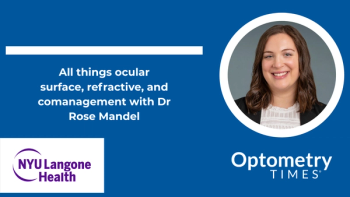
- January Digital Edition 2020
- Volume 12
- Issue 1
Remember the basics as dry eye treatments expand
Because of its prevalence, it’s more important than ever that ODs are well versed in DED.
Common and costly
Dry eye is one of the most common ophthalmic conditions, affecting hundreds of millions of people worldwide.
Dry eye has a significant impact on quality of life due to chronic symptoms of ocular pain and discomfort in addition to functional vision impairment. Dry eye can impact functional vision, interfering with everyday activities such as driving, reading, computer usage, watching television, and work performance.2 Dry eye negatively impacts mental health as dry eye patients report higher rates of anxiety and depression.3
Dry eye disease is among the most common reasons for visiting eye care practitioners and represents a substantial health and cost burden. Financially, dry eye is estimated to cost $3.84 billion per year to the healthcare system with an average annual cost of $783 per patient for treatment.4
Where to start
So, it is obvious that a lot of patients are suffering with dry eye. Dry eye is everywhere, going undiagnosed/underdiagnosed/undertreated, and our patients need our help. It is in our patients’ best interests to properly recognize and treat the condition.
Still, with the abundance of information available, it is easy for one to be overwhelmed with the data available. Where to start? How do I start? Do I really need all the bells and whistles available in the marketplace to properly diagnose and treat dry eye?
More to come
Which is where this project comes in. Over the course of this coming year, we will explore developing a dry eye subspecialty within optometric practices.
We will cover the nuts and bolts of starting a dry eye clinic, using the knowledge from experienced practitioners who have done just that in their practices. We aim to provide information on where to start, how to start, and some of the pitfalls and missteps along the way so you can avoid those stumbles.
Even more importantly, you’ll be providing a much-needed service to the scores of patients in
And who knows? You may have fun along the journey.
References:
1. Stapleton F, Alves M, Bunya VY, Jalbert, Lekhanont K, Malet F, Na KS, Schaumberg D, Uchino M, Vehof J, Viso E, Vitale S,
Jones L. TFOS DEWS II Epidemiology Report. Ocul Surf. 2017 Jul;15(3):334-365.
2. MiljanoviÄ B, Dana R, Sullivan DA, Schaumberg DA. Impact of dry eye syndrome on vision-related quality of life. Am J Ophthalmol. 2007 Mar;143(3):409 15.
3. Li M, Gong L, Sun X, Chapin WJ. Anxiety and depression in patients with dry eye syndrome. Curr Eye Res. 2011 Jan;36(1):1-7.
4. McDonald M, Patel DA, Keith MS, Snedecor SJ. Economic and humanistic burden of dry eye disease in Europe, North America, and Asia: a systematic literature review. Ocul Surf. 2016 Apr;14(2):144-167.
Articles in this issue
over 5 years ago
Why ODs should treat dry eyealmost 6 years ago
Go beyond fish oil with astaxanthin in krill oilalmost 6 years ago
Cotton-wool spots lead to tissue loss and RNFL defectalmost 6 years ago
SD-OCT shows schisis advancements due to sickle cellalmost 6 years ago
Why OAB should be considered before cataract removalalmost 6 years ago
Unlock the potential of refractive surgeryalmost 6 years ago
Cataract surgery problem solving: Is technology the answer?almost 6 years ago
Look at more than the optic nerve head in glaucoma patientsalmost 6 years ago
Sights are set on perfect vision in 2020Newsletter
Want more insights like this? Subscribe to Optometry Times and get clinical pearls and practice tips delivered straight to your inbox.



















































.png)


